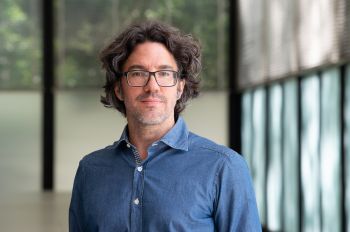Sponge-Like Building Material Developed at Illinois Tech Could Curb Carbon Emissions in Cities

Though large cities only occupy 2 percent of the world’s landmass, they’re responsible for approximately 70 percent of the world’s carbon dioxide emissions. But with the help of an Upjohn Grant from the American Institute Architects, researchers from Illinois Institute of Technology are developing a prototype cladding to combat carbon emissions in high-density areas.
The project, which started as a collaborative brainstorm between professors Rahman Azari of the College of Architecture and Mohammad Asadi of Armour College of Engineering, seeks to develop an artificial leaf-based facade cladding for use in urban buildings that can act as a sponge to absorb carbon dioxide in the air. Similar to photovoltaic solar panels, the cladding would draw in solar energy to transform carbon dioxide into methane, which in turn could be used as fuel in a building’s heating system.
“I was always interested in how we could have buildings that not only consume less energy, but also are positive in terms of their impact on the environment and ability to produce energy and capture carbon dioxide in the air,” says Azari. “Artificial leaf’s application in the building industry has basically been nonexistent, so I thought, ‘Let’s figure out how we can apply it in buildings.’”
A burgeoning technology, artificial leaf mimics the energy-generating process of photosynthesis. First successfully developed by American chemist Daniel G. Nocera in 2011, artificial leaf was created with the intent to produce hydrogen gas by splitting water molecules. The artificial leaf developed by Asadi, though, utilizes a catalyst that transforms carbon dioxide into methane, making it a scientific novelty.
“Methane is a kind of natural gas, so it can be used directly as fuel,” says Asadi. “Since we have an unlimited source in the sun and have plenty of carbon dioxide in the air, it’s easy to store, has a high energy density, and has potential to directly produce energy. It’s like electricity: you produce and then use it. So it’s a very useful and efficient process.”
Asadi is quick to point out that this chemical process is both carbon neutral—meaning the same amount of carbon dioxide created from the burning of methane produced is absorbed by the facade in making the carbon—and also produces pure oxygen as a byproduct, which can be used in a building’s HVAC system to refresh the air. That’s quite the bonus for the building’s occupants, given that studies indicate oxygen-rich environments can increase an individual’s cognitive performance.
The catalyst that forms the base for the cladding project so far has been lab proven, with Asadi noting an impressive stability over time; he suggests it could possibly remain productive on a building’s surface for as long as 50 years.
What’s uncharted territory for Asadi and Azari is the prospect of scaling the technology and testing a prototype for thermal, functional, and environmental performance. That is where the AIA Upjohn Grant comes in. With it, the duo hopes to build a full-sized prototype to explore the unknowns of enlarging the technology—those regarding thermodynamics, structure, real-world efficiency, and even aesthetics—and, ideally, to put the cladding on a building on Illinois Tech’s campus.
“That is the premise of this entire project,” says Azari. “We want to have an improved environmental performance of the building so it is no longer just about providing shelter and comfort for the occupants. It’s about meeting your responsibility to the environment.”




